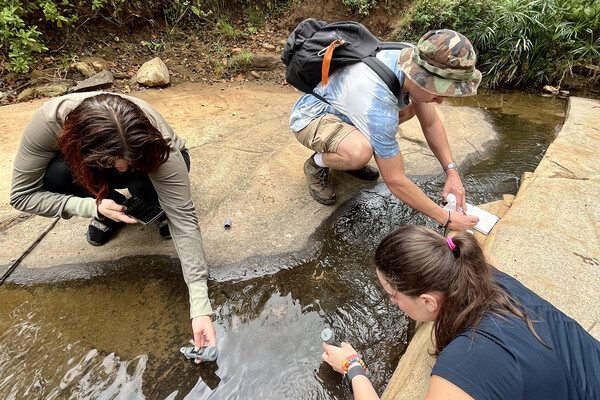
Griffin Pitt, right, works with two other student researchers to test the conductivity, total dissolved solids, salinity, and temperature of water below a sand dam in Kenya.
(Image: Courtesy of Griffin Pitt)
As society enters a new pandemic phase, with more than one-and-a-half billion doses of vaccines administered worldwide amidst concerns about new variants, the words and phrases used to make sense of the ongoing public health crisis are also evolving.
Penn Today shares a third update to the COVID-19 glossary, building off previous iterations published in June 2020 and December 2020, to provide insights on the ever-changing lexicon.
Variants: A subtype of a bacteria or virus whose genome differs from the primary strain but not enough to be considered an entirely new species. The relationship between a variant and a virus is akin to that of cultivars and the original species of plant from which it was derived.
There is currently no standardized method for naming virus variants; for COVID-19, variants are identified by letters followed by a sequence of numbers that indicate that they belong to a subgroup of a specific variant. Variants that start with B.1, for example, are related to a variant that was found during the outbreak in northern Italy in the spring of 2020. The World Health Organization (WHO) recommends against naming variants based on where they are found to avoid stigmatization, but references to the “U.K. variant” or “South African variant” are still prevalent.
For SARS-CoV-2, the WHO and the Centers for Disease Control and Prevention (CDC) designate three types of variants: variants of interest, variants of concern, and variants of high consequence.
A variant of interest has changes to its genome that are predicted to affect transmission rates, virus diagnosis or detection, effective treatments, or the variant’s ability to escape immune response. Researchers monitor variants of interest through genome sequencing and conduct additional laboratory and epidemiological studies to determine whether these mutations have a real-world impact.
To be considered a variant of concern, there must be scientific evidence that the variant has become more transmissible, causes more severe disease, leads to a major reduction in immune protection generated by a prior infection or vaccination, renders treatments less effective, or makes it more difficult to diagnose or detect the virus.
Variants of concern must be reported to the WHO and may require additional public health measures, such as increased testing or stricter social distancing measures, to reduce their spread. The CDC is currently tracking five variants of concern: B.1.1.7, B.1.351, B.1.427, B.1.429, and P.1.
Variants of high consequence are those with clear evidence that existing medical or prevention measures are not as effective in mitigating the disease or its effects. This could include a complete failure of diagnostics, a major reduction in vaccine efficacy, and more severe disease. There are currently no known variants of high consequence for SARS-CoV-2.
Genomic surveillance: Widespread genome sequencing of samples that are positive for SARS-CoV-2 to track variants. Each time a virus replicates, it also has to copy its genome (for SARS-CoV-2, the genome is made of 30,000 nucleotides), and this process is prone to random errors. These mistakes can lead to mutations, which sometimes can allow the virus to replicate or transmit more easily.
To detect variants, researchers sequence the entire virus genome and look for how its genes change over time. With information on which genes have changed and how that impacts the viruses’ biology, epidemiologists can then study whether the emergence of a new variant also corresponds with an increase in cases, hospitalizations, or breakthrough infections. Scientists set a benchmark of sequencing 5% of all positive samples.
Escape mutations: A change in a pathogen’s genome that allows it to bypass the body’s immune response. For SARS-CoV-2, the E484K mutation, a change in the sequence of the virus’ spike protein, has appeared in several known variants, including the B.1.351 variant. Recent clinical trial data showed that some vaccines, including Novavax and Johnson & Johnson, were less effective in South Africa, where the E484K mutation was circulating widely, than in the United Kingdom or the United States.
Vaccine certificates: An official record indicating that a person has received a vaccine. For COVID-19 vaccines in the U.S., details are filled in by vaccine providers on cards issued by the CDC, but some states, private businesses, and the international travel sector are interested in developing digital versions of so-called vaccine “passports” for ease of vaccination verification.
Before COVID-19, the WHO developed a “yellow card” as an official vaccination record that provides information on vaccination status certified by health care providers. This card is recognized internationally and is required for entry into certain countries. Some internationally regulated vaccinations include yellow fever, polio, and meningitis.
KN95: A type of filtering facepiece respirator, or FFR, similar to N95 masks but which goes through different certification channels.
A certified N95 masks is designed to filter out 95% or more of particles between 0.1 to 0.3 microns (the size of dust mites and pollen particles), which includes bacteria and viruses. In the U.S., N95 masks are tested and approved by the National Institute for Occupational Safety and Health.
KN95 masks are made using similar materials and design concepts as the N95 mask but are assessed and scored by China’s standards. While they are gaining in popularity, they are not considered to provide the same level of protection from inhalation of small, airborne particles.
Hygiene theater: Excessive cleaning and hygiene measures in public spaces, businesses, or private homes that provide a sense of health and safety without actually reducing the risks of COVID-19. Measures include excessive cleaning of high-touch surfaces, closing down rooms or buildings for deep cleaning, and banning cash transactions.
Recently, the CDC published updated guidance on disinfecting spaces, stating, “Based on available epidemiological data and studies of environmental transmission factors, surface transmission is not the main route by which SARS-CoV-2 spreads, and the risk is considered to be low.”
Re-entry anxiety: Uncertainty or trepidation at resuming pre-pandemic activities even once restrictions lift and people have been vaccinated. Advice from anxiety treatment experts includes following CDC guidelines without going “above and beyond” what is recommended, creating a decision tree to help structure activities safely, and avoiding getting stuck in “worry spirals.”
Viral vector vaccine: A biological preparation that provides immunity to a virus that uses a harmless version of another virus, known as the vector, to deliver instructions to the body on how to make antibodies that can fight off an infection. The vector does not contain any other genes that a virus requires for replication, so the vector itself cannot cause an infection.
For COVID-19, four viral vector vaccines have been approved by various countries or are in late-stage trials: Johnson & Johnson, Oxford/AstraZeneca, Sputnik V, and CanSino. These vaccines carry the genetic information for the SARS-CoV-2 spike protein inside an adenovirus vector.
Adenoviruses are a type of double-stranded DNA virus found in many vertebrate species, including humans, that cause a wide range of diseases. Adenoviruses have been developed as vectors for several types of vaccines, including vaccines under development for both MERS and Zika. Because the body has a number of neutralizing antibodies against common human adenoviruses, some vaccines under development, such as the one made by Oxford/AstraZeneca, use a modified chimpanzee adenovirus.
Other approaches for developing vaccines include using inactivated versions of the virus. These vaccines comprise virus that is no longer able to replicate but still has markers that the human body can use to develop its immune response, such as the spike proteins on COVID-19. Several inactivated vaccines that are in late-stage trials or approved for early use include Sinopharm, Sinovac, and Sinopharm-Wuhan from China and Bharat Biotech from India.
There are also protein-based vaccines in development for COVID-19, including the Novavax vaccine. These vaccines are made of nanoparticles dotted with SARS-CoV-2 spike proteins.
The first two vaccines approved for emergency use in the U.S., Pfizer-BioNTech and Moderna, are both RNA-based vaccines. These use messenger RNA (mRNA), which is taken up into a cell and made into a protein (in this case the SARS-CoV-2 spike protein), which then stimulates an immune response to protect against any future infections. This technology platform was made possible by previous research on mRNA at Penn.
Side effects: An impact of a treatment that is secondary or unintended to what the therapeutic was designed to do. For the COVID-19 vaccines, commonly reported side effects include pain, redness, or swelling in the arm where the vaccine was injected; tiredness; headache; muscle soreness; chills; fever; or nausea, with side effects more frequently reported after the second of a two-dose series.
In the U.S., the vaccine adverse event reporting system (VAERS) tracks reported side effects as well as more significant health problems, known as adverse events, that arise after a person has been vaccinated. If a pattern emerges that indicates a potential link between adverse events and a vaccine, additional follow-up and monitoring is conducted by the CDC, the FDA, and vaccine policy makers. This monitoring system led to the pause of the Johnson & Johnson vaccine roll-out this past spring.
Breakthrough infection: When someone who’s been vaccinated against a disease contracts the disease. Causes can include a breakdown of the vaccine itself before it is administered due to storage or administration errors, mutations in the virus that allow it to escape the immune system, or biological factors such as age that render a person’s immune system weaker.
For COVID-19, the CDC defines a breakthrough infection as a positive SARS-CoV-2 infection more than 14 days after someone received the full recommended series of doses, two weeks after the second dose for Pfizer and Moderna, and two weeks after the single dose of Johnson & Johnson.
Booster dose: An additional administration of a vaccine after the initial, or primer, dose. Boosters are designed to reexpose the body to a particular antigen in order to increase immune protection.
Boosters are useful because immune systems can lose memory of antigens over time due to antibody degradation. The tetanus vaccine, for example, requires boosters every 10 years for this reason. In addition, boosters can also prime the immune system against a virus as it evolves. Influenza viruses, for example, mutate frequently, so flu vaccines are updated annually to protect individuals from the most common mutations that are prevalent each year.
For COVID-19, it is not yet known how long immunity vaccine will last or whether the emergence of new variants will require updated boosters to confer full protection.
Universal vaccine: A biological preparation that provides immunity to all strains of a specific type of virus. Several universal flu vaccines are currently in development, and some work has been started to develop a universal coronavirus vaccine that would work against the viruses that cause COVID-19, SARS, and MERS.
Any suggestions for additional words or phrases to add to the list? Please contact Erica Brockmeier.
Erica K. Brockmeier

Griffin Pitt, right, works with two other student researchers to test the conductivity, total dissolved solids, salinity, and temperature of water below a sand dam in Kenya.
(Image: Courtesy of Griffin Pitt)

Image: Andriy Onufriyenko via Getty Images

nocred

Provost John L. Jackson Jr.
nocred